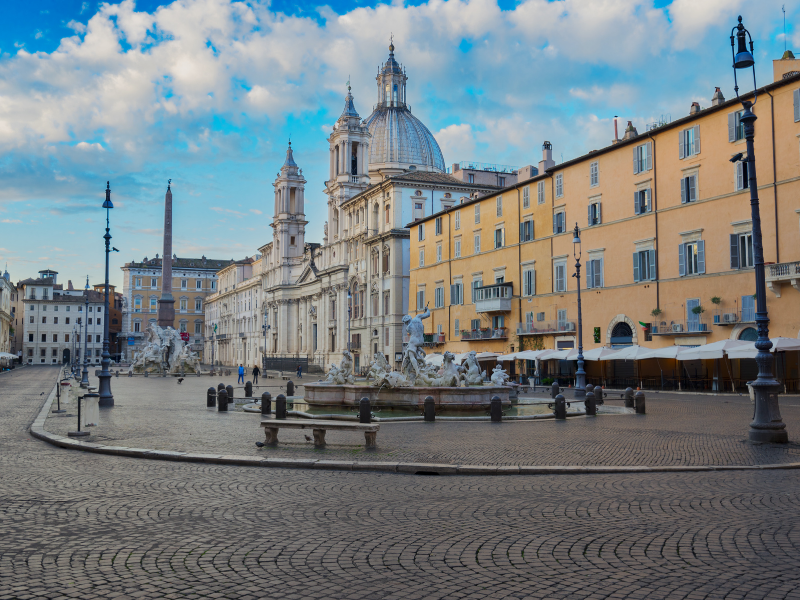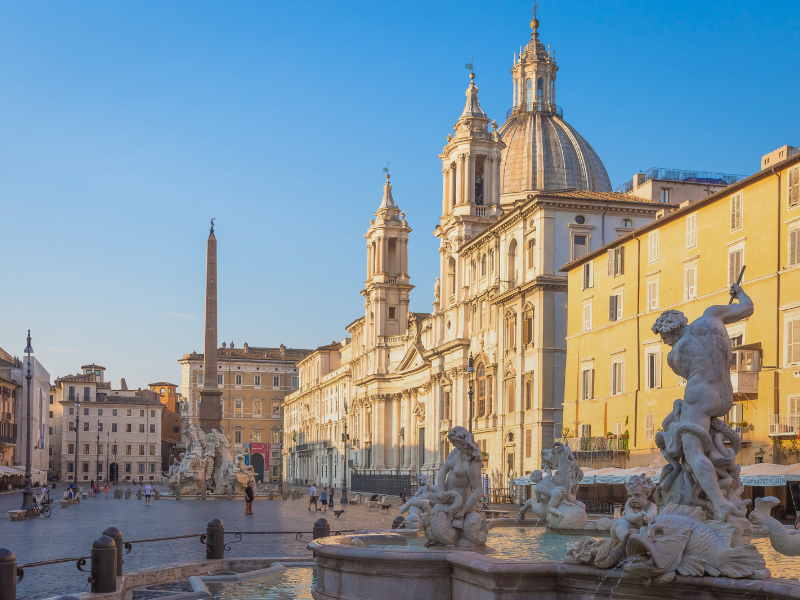Piazza Navona is one of Rome’s favorite squares with its beautiful baroque fountains, elegant facades, and bustling atmosphere. Situated on the site of an ancient Roman stadium, Piazza Navona has transformed into a central meeting place where locals and visitors gather to appreciate its beauty, sit in its cafes, and enjoy the ambiance of the Eternal City.
Historical Background
Origins of Piazza Navona
The beginnings of Piazza Navona can be traced back to ancient Rome when it was built as the Stadium of Domitian in AD 86 for athletic contests and public spectacles. The stadium, known as “Circus Agonalis,” had an elongated oval shape that is still reflected in the piazza’s layout today. The area remained in use for centuries before being turned into a square during the Renaissance.
Transformation into a Public Square
In the 15th century, Piazza Navona started taking on its current form as a public square. The remains of the old stadium were used as foundations for new buildings while the open space became a venue for markets, fairs, and other public events. It was not until the 17th century, under Pope Innocent X who was a member of the powerful Pamphili family, that Piazza Navona underwent a Baroque transformation becoming one of Rome’s most magnificent squares.
Baroque Revival
Several key additions were commissioned by Pope Innocent X from the Pamphili family which included Church of Sant’Agnese in Agone and Fountain of Four Rivers by Gian Lorenzo Bernini among others thus turning this square into an exemplarship for baroque art and architectural style.

Architectural and Artistic Details
Fountain of Four Rivers (Fontana dei Quattro Fiumi)
Overview
Standing at the center part is Fountain of Four Rivers which was created by Gian Lorenzo Bernini and completed in 1651. This colossal fountain is not only a beautiful work of art but also represents global power of Catholic Church during Baroque period.
Symbolism
It depicts four river gods each representing one major rivers known at that time which are Nile (Africa), Ganges (Asia), Danube (Europe) and Rio de la Plata (Americas). These rivers symbolize papal authority over different parts of the world. The central obelisk included by Bernini in the composition adds grandeur to this already magnificent water feature while serving as a reminder about ancient history of Rome.
Artistic Details
The statues show dynamic poses with animals and plants around them depicting their respective regions, all these being carved out life-size from single block material so as to maintain realism among other things. At the base there is a rocky formation designed to resemble an outcrop from which water falls down into large basin giving impression that it flows naturally downwards; this creates sense of movement or liveliness within static objects such as sculptures or buildings.
Other Fountains
Fontana del Moro
Located at the southern end of Piazza Navona, Fontana del Moro was designed by Giacomo della Porta in late 16th century but later modified by Bernini who added central figure of Moor wrestling with dolphin among other changes ensuring that it remains relevant even today.
Fountain of Neptune
At the top, the Fontana del Nettuno was designed by Giacomo della Porta and added to in the 19th century with more sculptures. The statue represents Neptune fighting with an octopus while other figures of frolicking cherubs and sea nymphs create an atmosphere that is energetic and lively around them.

Church of Sant’Agnese in Agone
Overview
Pope Innocent X commissioned the Church of Sant’Agnese in Agone, which stands on the west side of Piazza Navona. The church was designed by Girolamo Rainaldi, Carlo Rainaldi and Francesco Borromini. This Baroque façade and dome are an essential part of the square’s design, creating a harmonious fusion between architecture and art.
Architectural Significance
The church’s facade has graceful curves and ornamental features that are typical of baroque architecture. The interior is equally impressive with its lavishly decorated chapels, altars and magnificent dome. Borromini was driven by a competitive spirit during this period when he created his design for this building as it was intended to serve as a rival structure against Bernini’s nearby ‘Fountain of Four Rivers’.
Historical and Religious Significance
Sant’Agnese in Agone takes its name from St. Agnes who was a young Christian martyr killed at the Stadium of Domitian. It is believed that she was stripped naked at this place but miraculously her hair grew long enough to cover her body completely. A relic representing this saint is housed within these walls where people come on pilgrimages hoping to pay tribute to her memory.
Roman Culture Centre Role Of Piazza Navona
Social Hub
Throughout history Piazza Navona has been a favourite meeting point among Romans where they converged for socializing, trade activities and entertainment purposes. Currently bustling with life, one can find street performers or artists alongside tourists or locals enjoying meals at various coffee shops dotted around this square.
Celebrations And Festivals
La Befana Epiphany Fair (La Befana)
The Epiphany fair held every year around early January remains one popular event taking place at piazza Navona. During the fair grounds are transformed into festive markets boasting multiple stalls selling toys, sweets and other Christmas decorations. La Befana; a friendly witch who delivers presents to children on Epiphany day is always present to entertain visitors of all ages.
Cultural Events
Different cultural events such as art exhibitions, music shows or public demonstrations among others are often hosted in Piazza Navona throughout the year. These activities help create an energetic atmosphere within the square while giving tourists some insight into Roman culture and tradition.
Artists And Street Performers
Piazza Navona provides artists with a perfect platform to showcase their talents through street performances where they can easily captivate audiences with diverse acts. This includes painters displaying their works of art, caricaturists sketching images or even musicians entertaining crowds through playing different kinds of instruments. Such lively displays have made it become popular among people who love watching others perform various arts in one place.
How To Reach Piazza Navona
Location & Accessibility
Being situated right at the heart of Rome’s historic centre, Piazza Navona is easily reachable using public means or by foot from nearby attractions sites. The square is just a short distance away from Pantheon and Campo de’ Fiori thus making it an ideal stop when taking city walks.
- By Metro: Spagna (Line A) which lies approximately 15 minutes’ walk from this square represents the nearest metro station.
- By Bus: Several buses like 30, 70, 81 and 492 have stops close to piazza Navona.
- On Foot: Many major tourist destinations within Rome city including Pantheon,Trevi Fountain and Spanish Steps are found not far from here hence making it possible for one to reach by walking.
Ideal Seasons to Visit
You can go to Piazza Navona at any time of the day but it will be different anyway. The morning is quiet and peaceful, perfect for meditation and taking photos. In the late morning and afternoon, the place fills with tourists, artists, and street performers, turning into a lively and crowded space. Another great time to come here is in the evening when all the buildings are illuminated, restaurants are open, cafes are filled with people.
Useful Hints
Photography Tips
To take the best pictures of Piazza Navona:
Fountain of Four Rivers: Best moment to photograph this fountain is early in the morning or late in the afternoon when light gets soft and there are not so many people around.
Night Shots: Piazza Navona looks really beautiful at night. You could take some atmospheric shots of fountains and church during this time.
Wide-Angle Lens: Use wide-angle lens if you want to capture everything – square itself along with buildings located nearby.
Map
Nearby Attractions
Pantheon
Pantheon is one of Rome’s most iconic ancient buildings which is only 5 minutes’ walk from Piazza Navona. Recognized by its huge dome and historical value it should be visited alongside with Piazza Navona without fail.
Campo de’ Fiori
Located within a 10-minute walk from Piazza Navona Campo de’ Fiori has very vibrant market throughout daytime as well as lively nightlife after dark hours. It offers completely different but equally exciting atmosphere than seen at Piazza Navona so don’t miss it while being around.
Palazzo Altemps
Being Renaissance palace situated just few steps away from Piazza Navona Palazzo Altemps serves as home for museum displaying outstanding collection of classical statues among other artworks. Being less crowded attraction it gives additional knowledge about artistic heritage of Rome.



